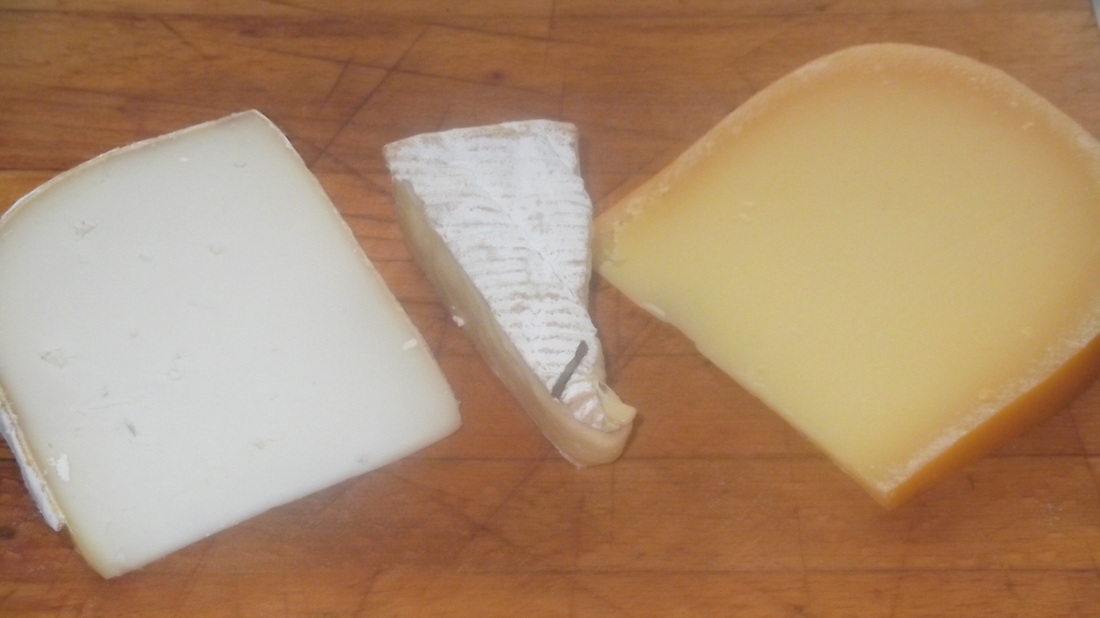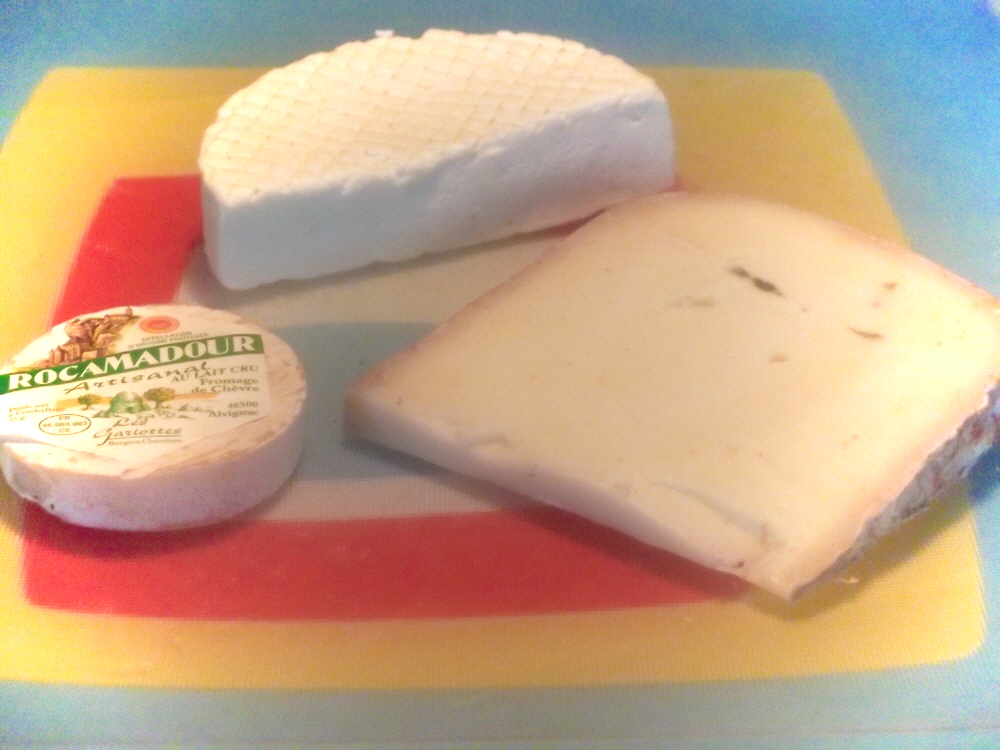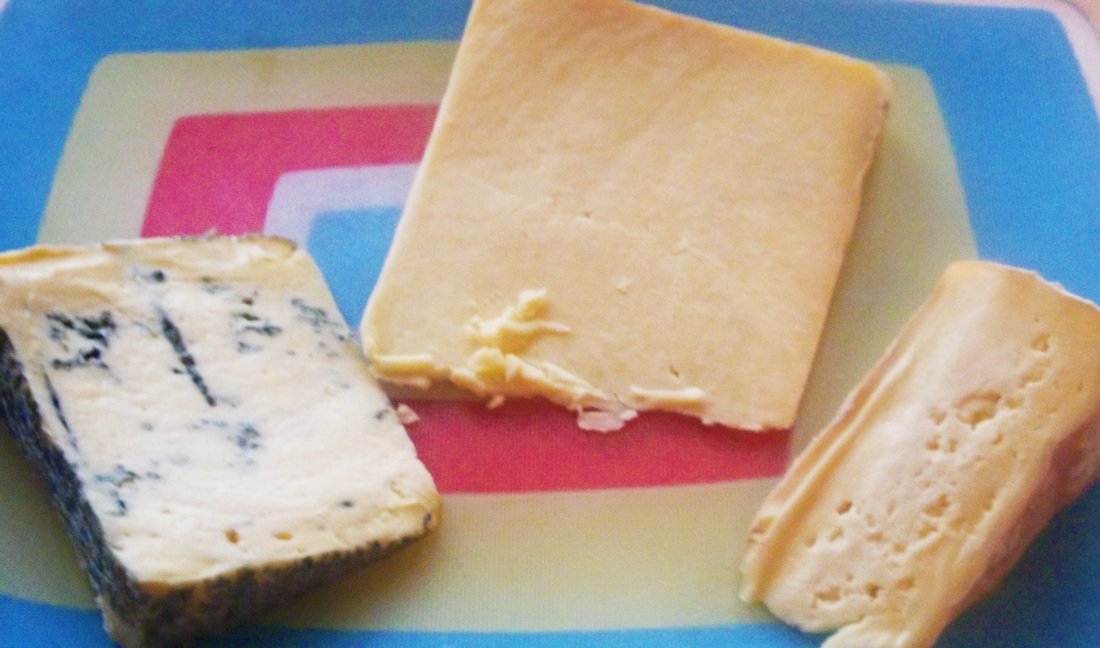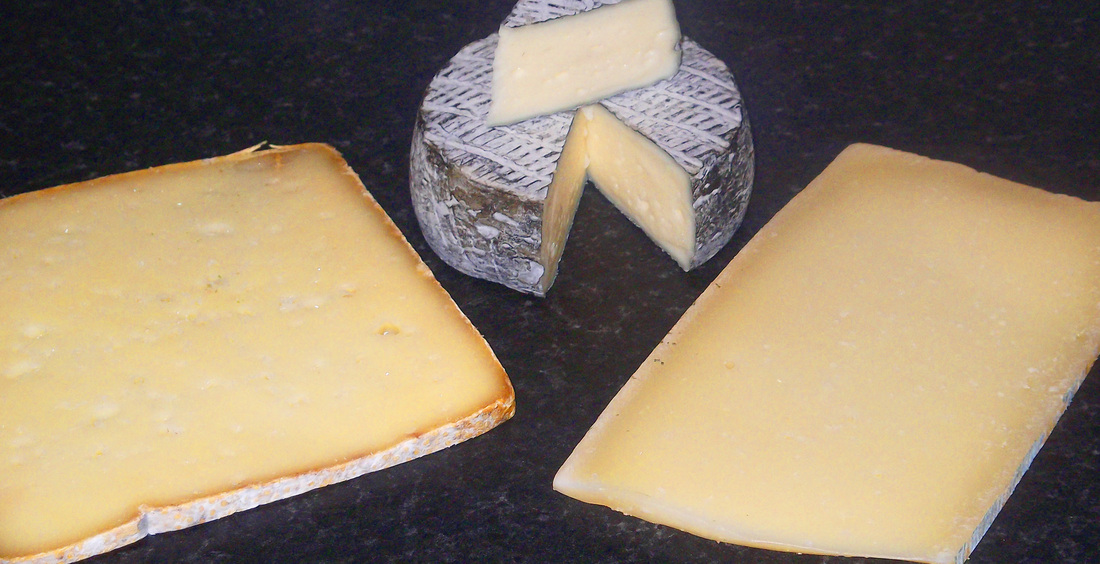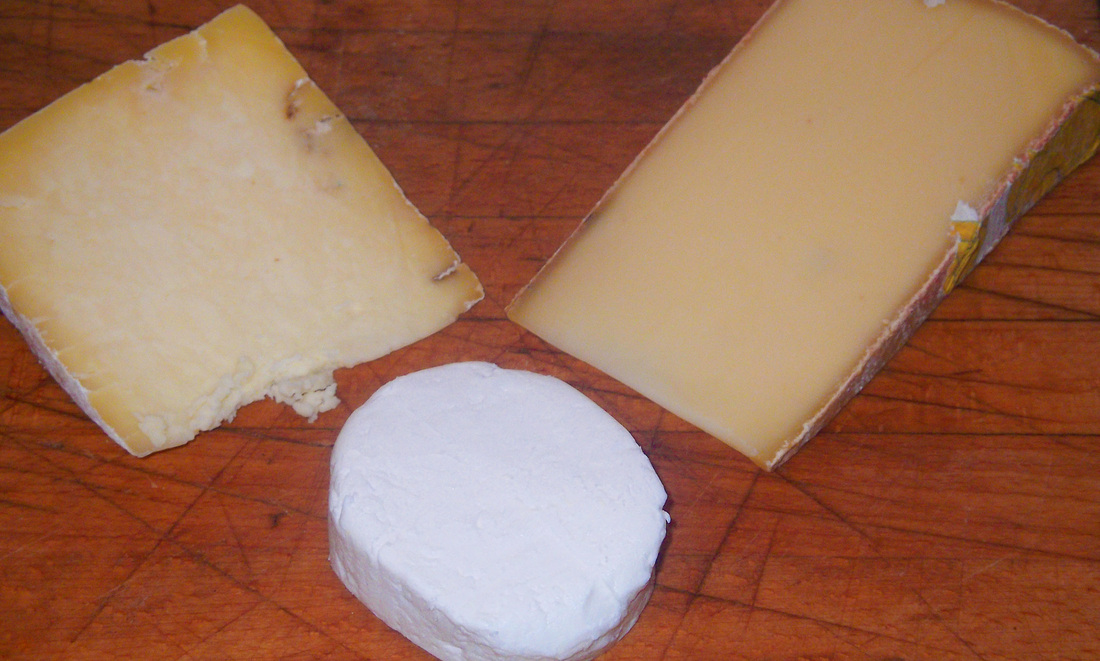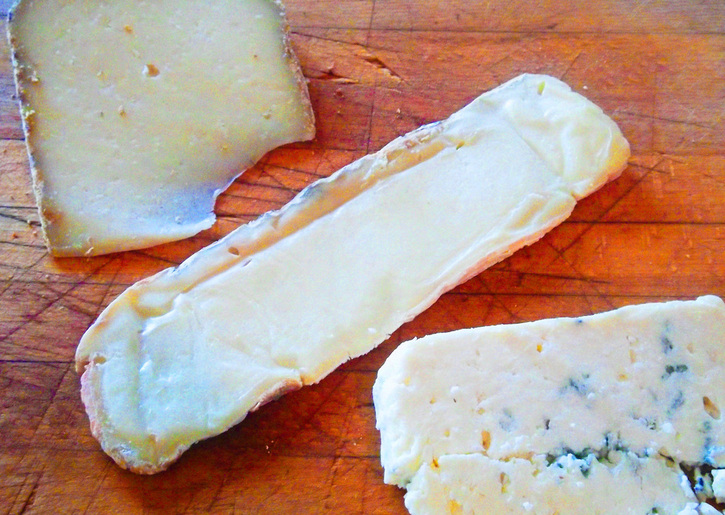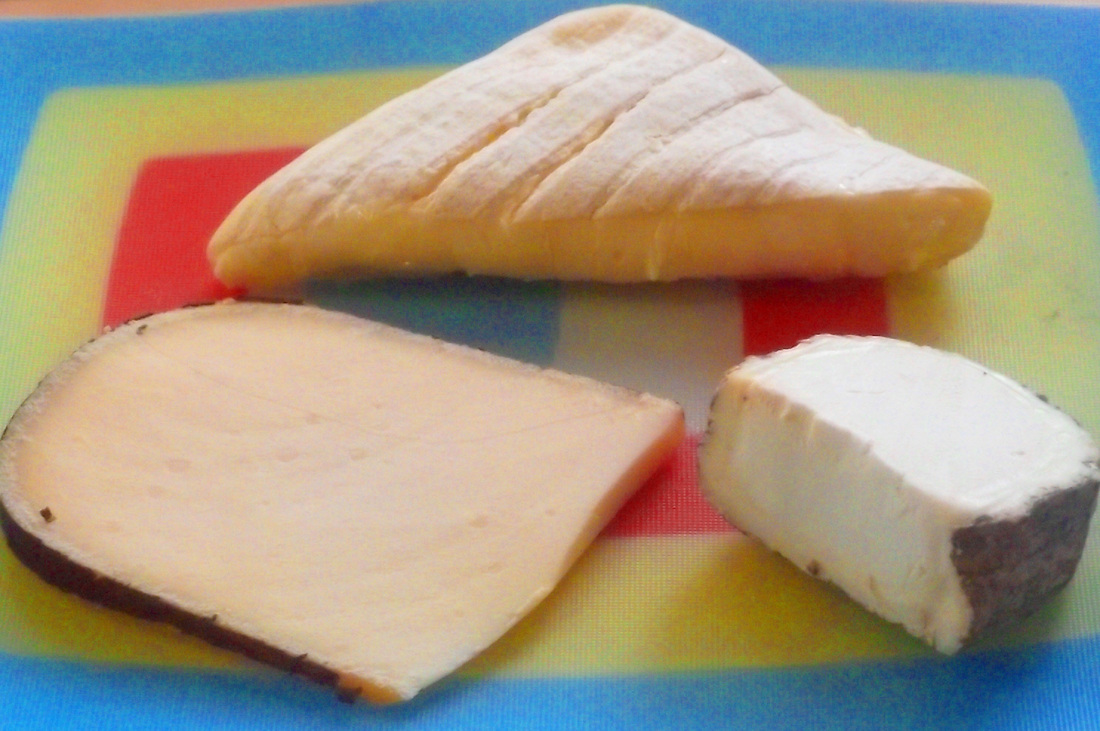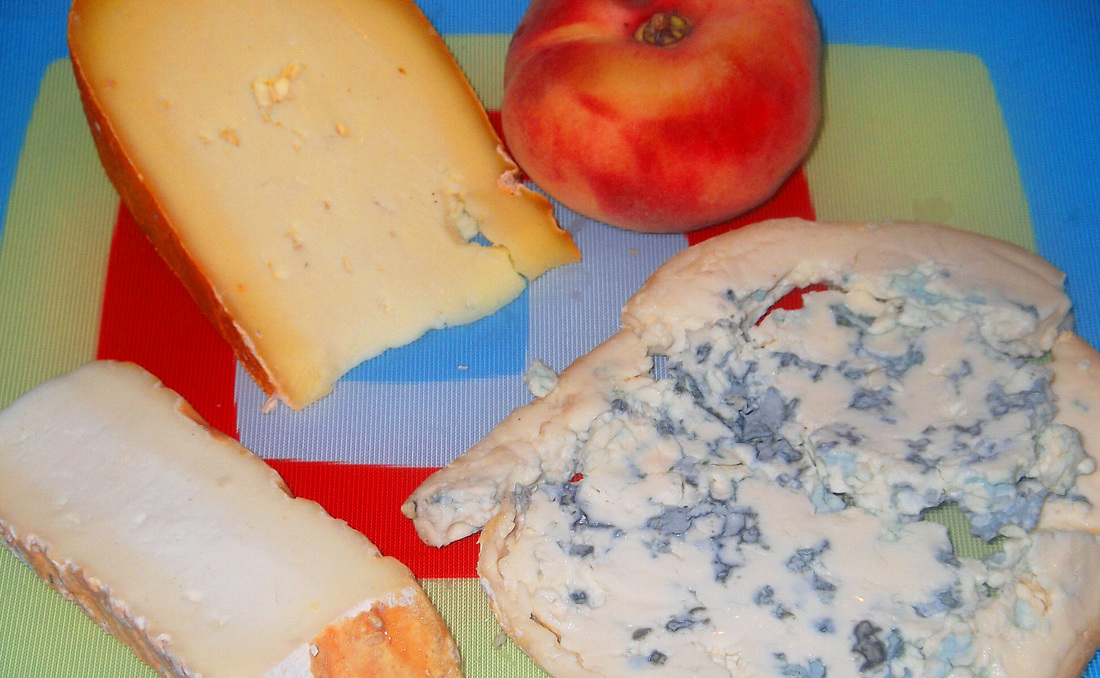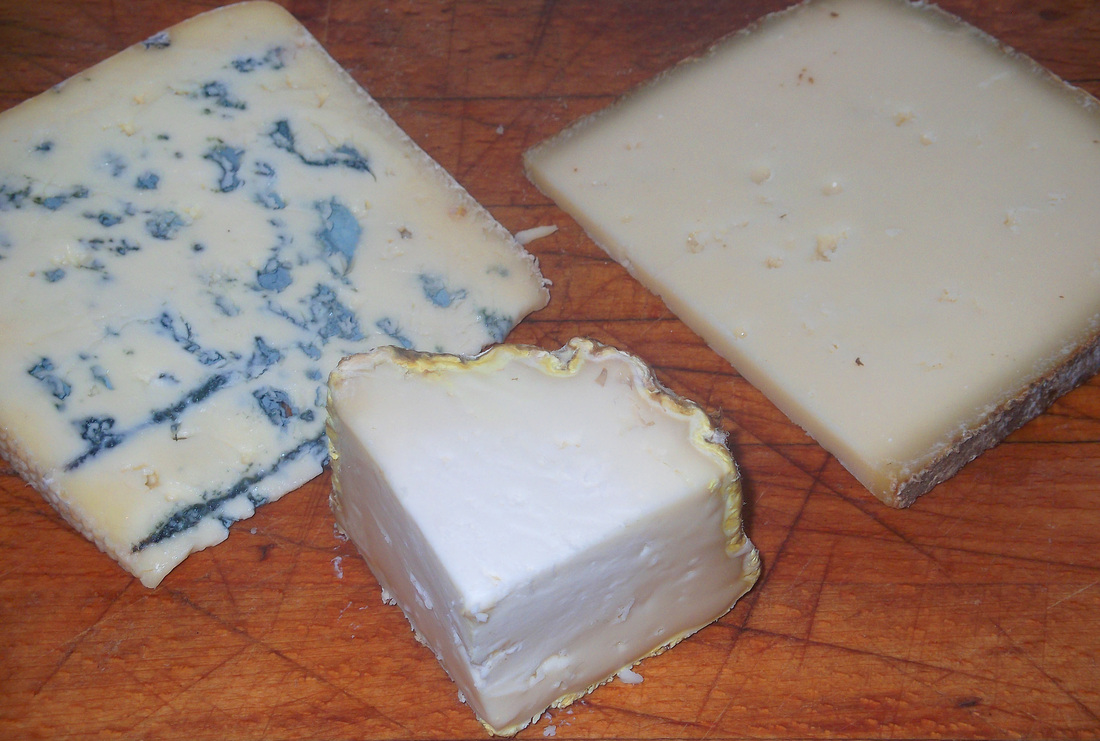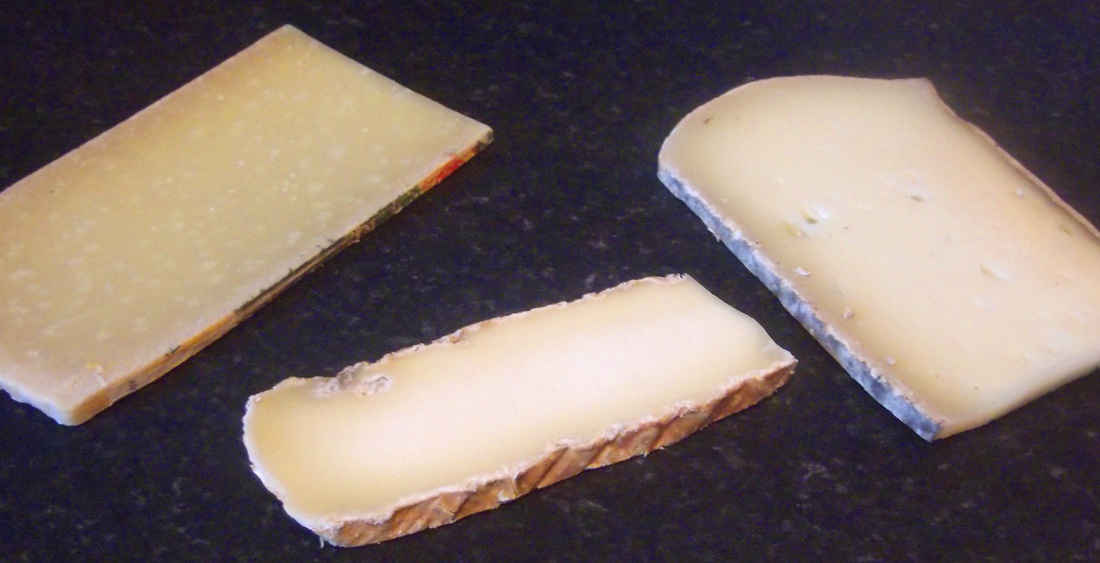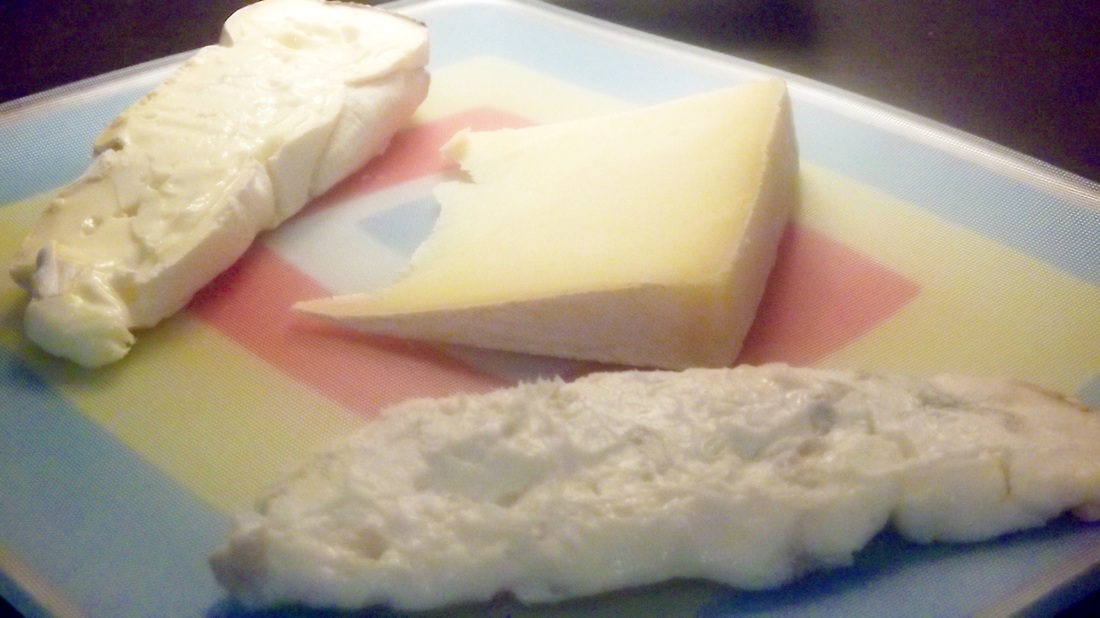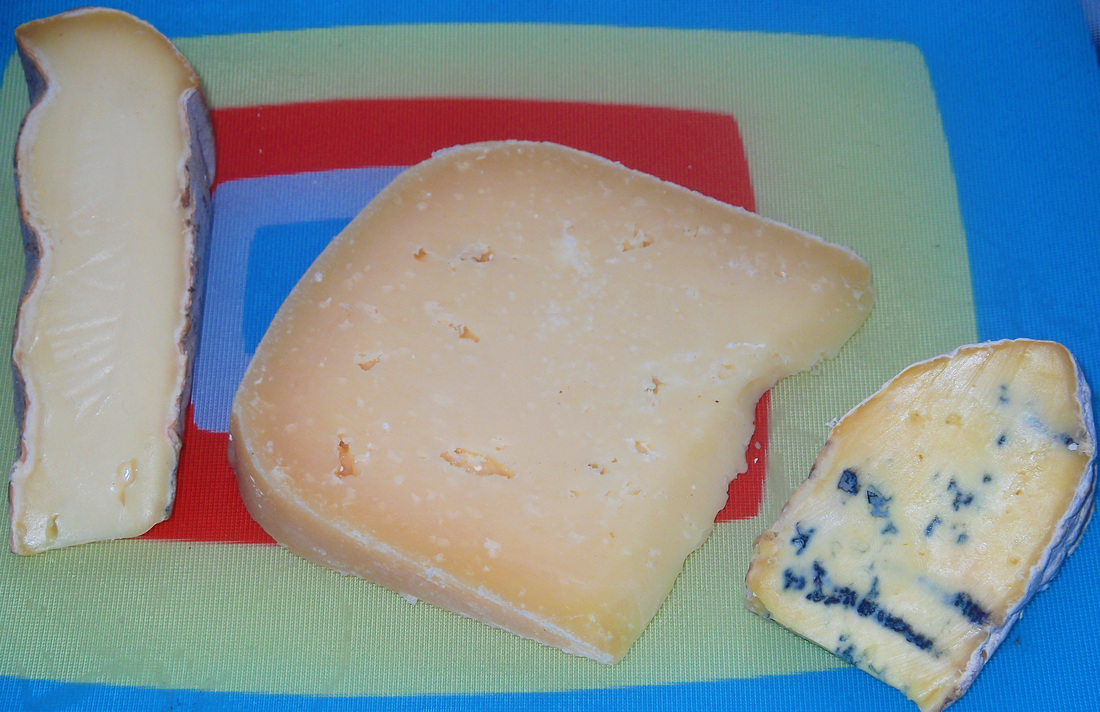cheese boards
OK, here's the thinking: if you are on a restricted budget, a chunk of really good cheese is going to be an occasional pleasure. But it doesn't have to be a totally unaffordable luxury - as long as you shop wisely and choose relatively small portions. No matter how borassic you are, if you can put aside 25p a day, then, once a month, you can enjoy a magnificent cheese selection for one or two people. Add a salad, a slice or two of sourdough bread and some perfectly ripe fruit and, my friend, you've got yourself some mighty fine eatin'.
So, by way of example, here are twelve monthly cheese boards, each made up of three different cheeses, for no more than £7.50 for each selection (these are 2012 prices). Well, I did go over that twice - once by five pence and once by four pence. Then again, the cheapest month cost £5.86 and the next £5.95. So, you know, swings and roundabouts. Or, perhaps, curds and whey.
So, by way of example, here are twelve monthly cheese boards, each made up of three different cheeses, for no more than £7.50 for each selection (these are 2012 prices). Well, I did go over that twice - once by five pence and once by four pence. Then again, the cheapest month cost £5.86 and the next £5.95. So, you know, swings and roundabouts. Or, perhaps, curds and whey.
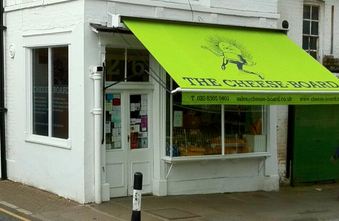
This project was a co-production between the development team here at the Skint Foodie Corp and the lovely people at the Cheeseboard in Greenwich - Robbyn and Lucy. It's been an absolute delight getting to know them both. The descriptions for each individual cheese are all their work. My role was primarily taking the stuff home and eating it.
There are ten goat's cheeses here: do give them a try, even (or especially) if you think you don't like goat's milk cheeses. I reckon when people say this, they're really recalling the acrid aftertaste at the back of the throat you get with one of those aged and wrinkly crottins. But, apart from perhaps the Rocamadour, that isn't the case with these. Try the Brinkburn or the Childwickbury - you'll be stunned.
Similarly, if you aren't a fan of blue cheeses , the Tomme Bluette, the Gorgonzola Dolce or the Fourme d'Ambert could well change your mind.
When we began, I thought I was quite the cheese afficianado. But something like 50% of the cheeses here were new to me. And although a few others, like the Vacherin, were already favourites of mine, there's still no room here for others such as Appleby Cheshire, Gorwydd Caerphilly and Stichelton. There are, praise be, many, many wonderful cheesemakers out there - we'd be fools not to try as many of their products as we can.
There are ten goat's cheeses here: do give them a try, even (or especially) if you think you don't like goat's milk cheeses. I reckon when people say this, they're really recalling the acrid aftertaste at the back of the throat you get with one of those aged and wrinkly crottins. But, apart from perhaps the Rocamadour, that isn't the case with these. Try the Brinkburn or the Childwickbury - you'll be stunned.
Similarly, if you aren't a fan of blue cheeses , the Tomme Bluette, the Gorgonzola Dolce or the Fourme d'Ambert could well change your mind.
When we began, I thought I was quite the cheese afficianado. But something like 50% of the cheeses here were new to me. And although a few others, like the Vacherin, were already favourites of mine, there's still no room here for others such as Appleby Cheshire, Gorwydd Caerphilly and Stichelton. There are, praise be, many, many wonderful cheesemakers out there - we'd be fools not to try as many of their products as we can.
january: brinkburn, fougerus and coolea
brinkburn
Pasteurised Goat's Milk
Brinkburn is handmade by The Northumberland Cheese Company which was established in 1984 by Mark Robertson in the lovely Rede Valley. In 1996 he moved the cheese making production to a renovated granary on the Blagdon Estate in South Northumberland. Using traditional methods with modern equipment, Mark has experimented with different flavour profiles and different maturation conditions. He has created an incredible mould-ripened goat’s cheese. It has a velvety soft, floury rind texture and a delicate, yet sophisticated flavour. It converts even those who insist they don’t like goat’s cheese.
Brinkburn is handmade by The Northumberland Cheese Company which was established in 1984 by Mark Robertson in the lovely Rede Valley. In 1996 he moved the cheese making production to a renovated granary on the Blagdon Estate in South Northumberland. Using traditional methods with modern equipment, Mark has experimented with different flavour profiles and different maturation conditions. He has created an incredible mould-ripened goat’s cheese. It has a velvety soft, floury rind texture and a delicate, yet sophisticated flavour. It converts even those who insist they don’t like goat’s cheese.
fougerus
Pasteurised Cow's Milk
Although this cheese is popular in France, it is not as well known here in the UK. We first came across it when we went to visit the Rouzaire family an hour outside Paris to see how they make our Brie de Meaux and our Brie de Nangis. Whilst showing us round, they gave us a taste of their Fougerus and we fell in love and placed our first order immediately.
Like most things in the world of cheese, Fougerus came about by accident, not intentionally. Robert Rouzaire was trying to perfect a new cheese, and, frustrated with a persistent flaw on the white, rind, placed a dried fern on top to hide the blemish. Initially, the Rouzaires made the cheese for family consumption only, keeping the fern leaf as decoration as well as flavouring. It was commercially produced for the first time in the 1960s when it caught the attention of a member of the public.
The interior paste is a beautiful, straw-coloured yellow and has occasional holes, or "eyes." When ripe, the interior will be runny and smooth.
In terms of flavour, Fougerus is balanced, with a buttery and creamy mouthfeel. There are distinct flavours of earth, mushrooms and nuts, complemented by savory vegetal notes.
Although this cheese is popular in France, it is not as well known here in the UK. We first came across it when we went to visit the Rouzaire family an hour outside Paris to see how they make our Brie de Meaux and our Brie de Nangis. Whilst showing us round, they gave us a taste of their Fougerus and we fell in love and placed our first order immediately.
Like most things in the world of cheese, Fougerus came about by accident, not intentionally. Robert Rouzaire was trying to perfect a new cheese, and, frustrated with a persistent flaw on the white, rind, placed a dried fern on top to hide the blemish. Initially, the Rouzaires made the cheese for family consumption only, keeping the fern leaf as decoration as well as flavouring. It was commercially produced for the first time in the 1960s when it caught the attention of a member of the public.
The interior paste is a beautiful, straw-coloured yellow and has occasional holes, or "eyes." When ripe, the interior will be runny and smooth.
In terms of flavour, Fougerus is balanced, with a buttery and creamy mouthfeel. There are distinct flavours of earth, mushrooms and nuts, complemented by savory vegetal notes.
coolea
Pasteurised Cow's Milk
Dick and Helene Willems moved from the South Netherlands to Ireland in the 1970s where they bought a farm in the Coolea mountains of West Cork. They soon began experimenting with making cheese for personal consumption, but so many people wanted the cheese that they started making it for commercial sale. They use an old Dutch Gouda recipe and make all the cheeses by hand.
It has a smooth texture, and tastes of caramel and hazelnuts, and is a bit sweet with hints of honey and butterscotch.
Dick and Helene Willems moved from the South Netherlands to Ireland in the 1970s where they bought a farm in the Coolea mountains of West Cork. They soon began experimenting with making cheese for personal consumption, but so many people wanted the cheese that they started making it for commercial sale. They use an old Dutch Gouda recipe and make all the cheeses by hand.
It has a smooth texture, and tastes of caramel and hazelnuts, and is a bit sweet with hints of honey and butterscotch.
february: rocamadour, childwickbury and tomme bluette chèvre
rocamadour
Unpasteurised Goat's Milk
From the Midi-Pyrénées, this little round disc belongs to the famous Cabecou family of French chèvres. In the dialect of the Languedoc 'cabecou' means 'little goat'. This cheese gets its name from the village in the Lot which nestles in the side of a cliff. The goats who roam here graze on varied and rich vegetation which impacts the flavour of the milk. These cheeses are available when very young and fresh, but I prefer them after they have had a chance to ripen for a few weeks - when they develop a peppery bite and becomes intensely 'goaty'.
From the Midi-Pyrénées, this little round disc belongs to the famous Cabecou family of French chèvres. In the dialect of the Languedoc 'cabecou' means 'little goat'. This cheese gets its name from the village in the Lot which nestles in the side of a cliff. The goats who roam here graze on varied and rich vegetation which impacts the flavour of the milk. These cheeses are available when very young and fresh, but I prefer them after they have had a chance to ripen for a few weeks - when they develop a peppery bite and becomes intensely 'goaty'.
childwickbury
Pasteurised Goat's Milk
Hand-made by Elizabeth Harris on the Childwickbury Estate near St Albans in Hertfordshire. A former research scientist, Elizabeth was looking to make a cheese during the day whilst her children were at school. So she chose a recipe that causes the curd to set in less than four hours.
This cheese is tangy with a slight sweetness to it. It's fantastic in a salad as well as on a cheeseboard.
Hand-made by Elizabeth Harris on the Childwickbury Estate near St Albans in Hertfordshire. A former research scientist, Elizabeth was looking to make a cheese during the day whilst her children were at school. So she chose a recipe that causes the curd to set in less than four hours.
This cheese is tangy with a slight sweetness to it. It's fantastic in a salad as well as on a cheeseboard.
tomme bluette chèvre
Unpasteurised Goat's Milk
A cheese from just inside the French border of the Basque country. This region runs from the Mediterranean to the Atlantic, forming a border which separates Spain and France. The people who live in the area do not consider themselves either French or Spanish, they are Basque. Within this region, cheese-making tends to be concentrated in Béarn , in the western quarter. There are over 100 cheeses in France that have the name 'tomme'. The root of the word is the Greek 'tomos' which means part of, or fraction of. Tomme's are often made using partial milkings. Originally, it was the term used for smaller alpine cheeses weighing a pound or less. Now, after hundreds of years, it is used as the name for many small round cheeses from all over France. This particular cheese has a wholly unique flavour profile, unlike any other blue cheese I have ever tasted; its creamy paste is full-flavoured and moreish. It is also a particularly unpredictable cheese - we have been importing it for four months now, and twice have received cheeses that had very little blue-ing inside, though this does not seem to effect the taste.
A cheese from just inside the French border of the Basque country. This region runs from the Mediterranean to the Atlantic, forming a border which separates Spain and France. The people who live in the area do not consider themselves either French or Spanish, they are Basque. Within this region, cheese-making tends to be concentrated in Béarn , in the western quarter. There are over 100 cheeses in France that have the name 'tomme'. The root of the word is the Greek 'tomos' which means part of, or fraction of. Tomme's are often made using partial milkings. Originally, it was the term used for smaller alpine cheeses weighing a pound or less. Now, after hundreds of years, it is used as the name for many small round cheeses from all over France. This particular cheese has a wholly unique flavour profile, unlike any other blue cheese I have ever tasted; its creamy paste is full-flavoured and moreish. It is also a particularly unpredictable cheese - we have been importing it for four months now, and twice have received cheeses that had very little blue-ing inside, though this does not seem to effect the taste.
march: cashel blue, mrs. kirkham's lancashire and ardrahan
cashel blue
Pasteurised Cow's Milk
Cashel Blue is handmade by Jane and Louis Grubb on their dairy farm at Beechmont, near Cashel in the valley of the Suir River, County Tipperary, Ireland - where the family have been farming since 1719.
In the early 1980s, Jane and Louis were looking to diversify the farm, and spent two years learning to make cheese. In 1984 they began making Cashel Blue - the first farmhouse blue cheese to be made in Ireland.
Most of their cheese is made from their ‘closed’ herd (they do not allow other cows to join the herd). It is full-flavoured, but not strong, with a touch of sweetness that balances the tangy notes and nutty blue veins.
It has much less salt than most blues, which makes it ideal for cooking.
Cashel Blue is handmade by Jane and Louis Grubb on their dairy farm at Beechmont, near Cashel in the valley of the Suir River, County Tipperary, Ireland - where the family have been farming since 1719.
In the early 1980s, Jane and Louis were looking to diversify the farm, and spent two years learning to make cheese. In 1984 they began making Cashel Blue - the first farmhouse blue cheese to be made in Ireland.
Most of their cheese is made from their ‘closed’ herd (they do not allow other cows to join the herd). It is full-flavoured, but not strong, with a touch of sweetness that balances the tangy notes and nutty blue veins.
It has much less salt than most blues, which makes it ideal for cooking.
mrs. kirkham's lancashire
Unpasteurised Cow's Milk
Graham Kirkham, from the third generation of the family, makes this cheese at Lower Beesley Farm near Goosenagh, in Lancashire. There are only a handful of cheese-makers still making traditional Lancashire.
The milk comes from their small herd of Friesian-Holstein cows that are cared for by Graham’s father John Kirkham, and until only a few years ago Graham’s mum Ruth made the cheese herself.
Each morning Graham adds raw, cooled milk from the previous evening's milking to the warm, morning milk. Starter culture and rennet are added before the curd is cut by hand and allowed to settle, thereby retaining as much fat as possible within the curd.
In keeping with traditional Lancashire production, Graham then mixes curd from the previous day's production in equal quantities with the curd from the current batch. The cheeses are matured for at least six weeks which produces a cheese that is mild, creamy and slightly crumbly. The texture is moist and rich, and the flavours are buttery, lemony and yoghurty, with a pronounced tang and a long, rounded finish.
Graham Kirkham, from the third generation of the family, makes this cheese at Lower Beesley Farm near Goosenagh, in Lancashire. There are only a handful of cheese-makers still making traditional Lancashire.
The milk comes from their small herd of Friesian-Holstein cows that are cared for by Graham’s father John Kirkham, and until only a few years ago Graham’s mum Ruth made the cheese herself.
Each morning Graham adds raw, cooled milk from the previous evening's milking to the warm, morning milk. Starter culture and rennet are added before the curd is cut by hand and allowed to settle, thereby retaining as much fat as possible within the curd.
In keeping with traditional Lancashire production, Graham then mixes curd from the previous day's production in equal quantities with the curd from the current batch. The cheeses are matured for at least six weeks which produces a cheese that is mild, creamy and slightly crumbly. The texture is moist and rich, and the flavours are buttery, lemony and yoghurty, with a pronounced tang and a long, rounded finish.
ardrahan
Pasteurised Cow's Milk
Ardrahan is a type of washed-rind cheese whose name means 'height of the ferns', and is one of Ireland's best loved washed-rind cheeses. Washed rind cheeses are particularly well suited to County Cork as the climate is ideal: mild and damp, with the Atlantic spray rising off the coast, seasoning the air with a salty tang.
It is made in Kanturk, County Cork by the Burns family who have been dairy farmers for generations. Eugene Burns Senior established a herd of pedigree Friesians in 1925. The lush countryside of the Duhallow region in Co Cork, is famous for its rich, fertile grazing and clean environment - the perfect backdrop for producing this premium cheese. In 1983 Eugene Senior’s son, also Eugene, and his wife Mary turned their hands to cheese making. Their first customers were actually in France at Rungis Market as the pungent smell of Ardrahan seemed foreign to 1980s Ireland.
However, it wasn’t long before they were selling cheese in London and shops all over Ireland as well. The business is still a family affair. Sadly, Eugene died in 2000, but Mary is now supported by her children in running the farm and making the cheese.
Ardrahan cheese has a buttery textured honey-coloured centre with a complex delicate flavour. It has a washed rind which grows into a golden colour, and its size and weight tend to vary slightly due to the fact that it is a hand-made product.
Ardrahan is lovely with an earthy, salty, gritty exterior from having a washed rind. Yes, it's stinky, but not overly so. Barnyard funky, yet with notes of sea air and saltiness.
Ardrahan is a type of washed-rind cheese whose name means 'height of the ferns', and is one of Ireland's best loved washed-rind cheeses. Washed rind cheeses are particularly well suited to County Cork as the climate is ideal: mild and damp, with the Atlantic spray rising off the coast, seasoning the air with a salty tang.
It is made in Kanturk, County Cork by the Burns family who have been dairy farmers for generations. Eugene Burns Senior established a herd of pedigree Friesians in 1925. The lush countryside of the Duhallow region in Co Cork, is famous for its rich, fertile grazing and clean environment - the perfect backdrop for producing this premium cheese. In 1983 Eugene Senior’s son, also Eugene, and his wife Mary turned their hands to cheese making. Their first customers were actually in France at Rungis Market as the pungent smell of Ardrahan seemed foreign to 1980s Ireland.
However, it wasn’t long before they were selling cheese in London and shops all over Ireland as well. The business is still a family affair. Sadly, Eugene died in 2000, but Mary is now supported by her children in running the farm and making the cheese.
Ardrahan cheese has a buttery textured honey-coloured centre with a complex delicate flavour. It has a washed rind which grows into a golden colour, and its size and weight tend to vary slightly due to the fact that it is a hand-made product.
Ardrahan is lovely with an earthy, salty, gritty exterior from having a washed rind. Yes, it's stinky, but not overly so. Barnyard funky, yet with notes of sea air and saltiness.
april: dobbiaco, carboncino and montasio
dobbiaco
Unpasteurised Cow's Milk
This is a rare washed-rind cheese produced in the Trento-Adige region of Italy. It takes its name from the Dobbiaco area in the Val Pusteria, but it is also produced in other parts of Alto Adige. It has a sticky rind and a supple texture. The flavours are a balance of barnyard and butter, with a bit of sweetness.
This is a rare washed-rind cheese produced in the Trento-Adige region of Italy. It takes its name from the Dobbiaco area in the Val Pusteria, but it is also produced in other parts of Alto Adige. It has a sticky rind and a supple texture. The flavours are a balance of barnyard and butter, with a bit of sweetness.
carboncino
Pasteurised Cow's, Goat's and Ewe's Milk
This is a beautiful, small cheese from Caseficio dell’Alta Langa in Piedmont. It is made with equal parts cow, goat and ewe’s milk; but the flavour is less “goaty” than other triple milk cheeses from the region, such as Robiola alta Langa. Carboncino is fully-ashed with a growth of white mould, giving it a dappled black and white colour over its patterned rind. The texture is creamy and yielding and the cheese melts in the mouth. Carboncino is relatively new, having only been created a few years ago.
This is a beautiful, small cheese from Caseficio dell’Alta Langa in Piedmont. It is made with equal parts cow, goat and ewe’s milk; but the flavour is less “goaty” than other triple milk cheeses from the region, such as Robiola alta Langa. Carboncino is fully-ashed with a growth of white mould, giving it a dappled black and white colour over its patterned rind. The texture is creamy and yielding and the cheese melts in the mouth. Carboncino is relatively new, having only been created a few years ago.
montasio
Unpasteurised Cow's Milk
Montasio has been made since the 13th century in the region of Friuli Venezia Giulia. The cheese takes its name from the group of mountains in the Julian Alps. It was originally produced by Benedictine monks, at the Abbey of Moggio, using ewe’s milk. Today, it is made with cow’s milk by skimming the cream off the evening milk and then mixing it with the morning milk. The cheese was awarded DOP status (the Italian mark of protected origin) in the 1980s. As a result, only milk from dairy farms in the region may be used and the cheese must be made using slow traditional methods. The flavour of Montasio is delicate and fresh, with notes of sweet grass and hay, reflecting the terroir of the region.
Montasio has been made since the 13th century in the region of Friuli Venezia Giulia. The cheese takes its name from the group of mountains in the Julian Alps. It was originally produced by Benedictine monks, at the Abbey of Moggio, using ewe’s milk. Today, it is made with cow’s milk by skimming the cream off the evening milk and then mixing it with the morning milk. The cheese was awarded DOP status (the Italian mark of protected origin) in the 1980s. As a result, only milk from dairy farms in the region may be used and the cheese must be made using slow traditional methods. The flavour of Montasio is delicate and fresh, with notes of sweet grass and hay, reflecting the terroir of the region.
may: cotherstone, perroche and toggenburger nidelchäs
cotherstone
Pasteurised Cow's Milk
Cotherstone is made by Joan Cross in Barnard Castle, County Durham. Joan uses a simple recipe and process: she lets the milk sour and curdle before milling the curd and placing it in moulds. This basic style of cheese was traditionally made by farmers' wives to feed the family. As such, the cheese was always made on a small-scale and Cotherstone is no exception. Joan used to make the cheese in her kitchen and although she now makes it in a dedicated dairy there is still limited supply. Cotherstone is similar to other cheeses from the Yorkshire and Pennine Hills area, such as Wensleydale and Swaledale. It has lactic, lemony flavours and a crumbly texture.
Cotherstone is made by Joan Cross in Barnard Castle, County Durham. Joan uses a simple recipe and process: she lets the milk sour and curdle before milling the curd and placing it in moulds. This basic style of cheese was traditionally made by farmers' wives to feed the family. As such, the cheese was always made on a small-scale and Cotherstone is no exception. Joan used to make the cheese in her kitchen and although she now makes it in a dedicated dairy there is still limited supply. Cotherstone is similar to other cheeses from the Yorkshire and Pennine Hills area, such as Wensleydale and Swaledale. It has lactic, lemony flavours and a crumbly texture.
perroche
Unpasteurised Goat’s Milk
Perroche Log is handmade by Charlie Westhead and his family in Herefordshire. This is a very young cheese that has yet to develop a rind. Even though it is quite young, it is great for cooking. The flavours are fresh and delicate without being what most people think of as too ‘goaty’.
Perroche Log is handmade by Charlie Westhead and his family in Herefordshire. This is a very young cheese that has yet to develop a rind. Even though it is quite young, it is great for cooking. The flavours are fresh and delicate without being what most people think of as too ‘goaty’.
toggenburger nidelchäs
Thermised Cow's Milk
Toggenburger Nidelchäs is made by Philipp Muller at the Neuwies dairy in Toggenburg, Switzerland. It has the distinguishable orangey-pink outside of a 'washed rind' cheese. This means that the cheese is washed regularly in a brine solution during the five months it is matured. It has complex nutty aromas, with hints of hay and mountain flowers. The flavour of the creamy inside is bold and beefy, and intensified by the pungent rind. The milk used to make Toggenburger Nidelchäs is thermised, meaning that it has been partially heat treated. Thermising is gentler than pasteurisation: the milk (and, therefore, the cheese) retains more flavour than if it had been pasteurised. This process is particularly common in Switzerland and most famously used to make Swiss Vacherin Mont d'Or.
Toggenburger Nidelchäs is made by Philipp Muller at the Neuwies dairy in Toggenburg, Switzerland. It has the distinguishable orangey-pink outside of a 'washed rind' cheese. This means that the cheese is washed regularly in a brine solution during the five months it is matured. It has complex nutty aromas, with hints of hay and mountain flowers. The flavour of the creamy inside is bold and beefy, and intensified by the pungent rind. The milk used to make Toggenburger Nidelchäs is thermised, meaning that it has been partially heat treated. Thermising is gentler than pasteurisation: the milk (and, therefore, the cheese) retains more flavour than if it had been pasteurised. This process is particularly common in Switzerland and most famously used to make Swiss Vacherin Mont d'Or.
june: le massadel, taleggio and beenleigh blue
le massadel
Unpasteurised Goat's Milk
This is a brand new cheese that our French suppliers were very excited to introduce to us, and we immediately loved it. It is a farmhouse cheese handmade by Jean-Marie Ompraret and his son.
The Ompraret family herd cows and goats 1800 metres up a mountain called Col de Soulor in the Pyrenees. They make about 10 cheeses per day.
Once a week the local affineur, M. Calendri, selects cheeses from the farm, and matures them for 3-6 months.
Massadel is the name given to people living in the town of Massat near Lourdes.
This is a brand new cheese that our French suppliers were very excited to introduce to us, and we immediately loved it. It is a farmhouse cheese handmade by Jean-Marie Ompraret and his son.
The Ompraret family herd cows and goats 1800 metres up a mountain called Col de Soulor in the Pyrenees. They make about 10 cheeses per day.
Once a week the local affineur, M. Calendri, selects cheeses from the farm, and matures them for 3-6 months.
Massadel is the name given to people living in the town of Massat near Lourdes.
taleggio
Unpasteurised Cow's Milk
This cheese was originally made by families during the 10th Century in the Val Taleggio which is near Bergamo in Lombardy, although it wasn’t called Taleggio until the 20th Century. The cheeses are washed in brine to prevent unwanted moulds from growing. This brine gives the cheese its signature pinkish-orange colour and also encourages the barnyard aromas and flavours associated with Taleggio. It has a supple texture and melts in your mouth. This texture makes it ideal for cooking: try it in a tart or sliced into a polenta dish.
This cheese was originally made by families during the 10th Century in the Val Taleggio which is near Bergamo in Lombardy, although it wasn’t called Taleggio until the 20th Century. The cheeses are washed in brine to prevent unwanted moulds from growing. This brine gives the cheese its signature pinkish-orange colour and also encourages the barnyard aromas and flavours associated with Taleggio. It has a supple texture and melts in your mouth. This texture makes it ideal for cooking: try it in a tart or sliced into a polenta dish.
beenleigh blue
Unpasteurised Ewe's Milk
Beenleigh, one of only three blue ewes' milk cheeses made in Britain, is made at the Ticklemore Dairy in Sharpham Barton just outside Totnes in Devon. It was created in the 1980s by former banker Robin Congdon who used his previous experience making Roquefort in France when creating this creamy and crumbly ewes milk blue cheese. He made it with his wife Sari for many years, and it is now made by Ben Harris.
The rough, crusty, natural rind is slightly sticky and has some patches of gray and white moulds. It has a moist and crumbly texture with a patchwork blue green mould running through an ivory paste. The flavour is rich and slightly sweet, we love to have it for dessert on its own with some fruit and nuts.
It is matured for six months and is available from early summer through to winter.
Beenleigh, one of only three blue ewes' milk cheeses made in Britain, is made at the Ticklemore Dairy in Sharpham Barton just outside Totnes in Devon. It was created in the 1980s by former banker Robin Congdon who used his previous experience making Roquefort in France when creating this creamy and crumbly ewes milk blue cheese. He made it with his wife Sari for many years, and it is now made by Ben Harris.
The rough, crusty, natural rind is slightly sticky and has some patches of gray and white moulds. It has a moist and crumbly texture with a patchwork blue green mould running through an ivory paste. The flavour is rich and slightly sweet, we love to have it for dessert on its own with some fruit and nuts.
It is matured for six months and is available from early summer through to winter.
july: gutshofer ziegenkäse, robiola bosina and monte enebro
gutshofer ziegenkäse
Unpasteurised Goat's Milk
Made by the Gutshofer family on a farm in the Twente area of the Netherlands, near the border with Germany. This is a hard cheese which is ripened in warm cellars; towards the end of the ripening period the cheeses are rubbed with caramel. This version was ripened for 8 months, and has a firm but creamy paste with a unique moreish slightly salty taste with a definite caramel note.
Made by the Gutshofer family on a farm in the Twente area of the Netherlands, near the border with Germany. This is a hard cheese which is ripened in warm cellars; towards the end of the ripening period the cheeses are rubbed with caramel. This version was ripened for 8 months, and has a firm but creamy paste with a unique moreish slightly salty taste with a definite caramel note.
robiola bosina
Pasteurised Cow's and Ewe's Milk
This is a classic, mixed milk Italian Robiola made in Northern Italy, in the Langhe region. It has a bloomy rind, a soft and supple texture and a luscious, rich interior that becomes creamy and a bit runny when left at room temperature. The flavours are a lovely mild balance - milky, slightly salty and a bit mushroomy.
This is a classic, mixed milk Italian Robiola made in Northern Italy, in the Langhe region. It has a bloomy rind, a soft and supple texture and a luscious, rich interior that becomes creamy and a bit runny when left at room temperature. The flavours are a lovely mild balance - milky, slightly salty and a bit mushroomy.
monte enebro
Pasteurised Goat's Milk
Made in Avila, near Madrid, this was created only a few decades ago by Rafael Baez after, having retired from a career in engineering, he enrolled in an artisanal cheese-making course . Monte Enebro has since won numerous awards over the years and is shipped all over the world. The exterior of this log-shaped cheese is sprayed with the same blue mold used in making Roquefort. The texture is dense and creamy with a light lemony assertive bite to it.
Made in Avila, near Madrid, this was created only a few decades ago by Rafael Baez after, having retired from a career in engineering, he enrolled in an artisanal cheese-making course . Monte Enebro has since won numerous awards over the years and is shipped all over the world. The exterior of this log-shaped cheese is sprayed with the same blue mold used in making Roquefort. The texture is dense and creamy with a light lemony assertive bite to it.
august: cardo, mahon and fourme d'ambert
cardo
Unpasteurised Goat's Milk
Cardo is handmade by Mary Holbrook on Sleight Farm in Somerset. It is a semi-soft washed-rind goat’s milk cheese that is washed in water (rather than brine) while it matures. She uses a vegetarian rennet made from cardoon stamens (from which it gets its name) which is related to the artichoke and is commonly used in Portuguese cheese-making. The rind adds savouriness to the delicate floral flavours of the pâte. This cheese is unusual in that it is truly a seasonal cheese, produced only between March and October, the natural kidding cycle for goats.
Cardo is handmade by Mary Holbrook on Sleight Farm in Somerset. It is a semi-soft washed-rind goat’s milk cheese that is washed in water (rather than brine) while it matures. She uses a vegetarian rennet made from cardoon stamens (from which it gets its name) which is related to the artichoke and is commonly used in Portuguese cheese-making. The rind adds savouriness to the delicate floral flavours of the pâte. This cheese is unusual in that it is truly a seasonal cheese, produced only between March and October, the natural kidding cycle for goats.
mahon
Unpasteurised Cow's Milk
Mahon is named after the capital of Menorca where it is made. The Tramuntana wind (known as the Tramontane in France) is the north wind that blows sea salt over the pastures that the cows eat from and lends a particularly salty characteristic to this cheese.
During the cheese-making process, the curds are wrapped in a cloth square and the corners are tautly tied, which gives the cheese its signature shape of a fat cushion. It is then washed in brine and rubbed with olive oil and paprika. This gives it its beautiful colour and also contributes to its tangy, intense flavours.
It is matured by Nicolas Cardona, one of only two Afinadores on the island of Menorca. He follows in the footsteps of his father and grandfather; his role is to select the cheeses and mature them - including brining and turning them by hand until they are perfect.
Mahon is named after the capital of Menorca where it is made. The Tramuntana wind (known as the Tramontane in France) is the north wind that blows sea salt over the pastures that the cows eat from and lends a particularly salty characteristic to this cheese.
During the cheese-making process, the curds are wrapped in a cloth square and the corners are tautly tied, which gives the cheese its signature shape of a fat cushion. It is then washed in brine and rubbed with olive oil and paprika. This gives it its beautiful colour and also contributes to its tangy, intense flavours.
It is matured by Nicolas Cardona, one of only two Afinadores on the island of Menorca. He follows in the footsteps of his father and grandfather; his role is to select the cheeses and mature them - including brining and turning them by hand until they are perfect.
fourme d'ambert
Unpasteurised Cow's Milk
Perfect for those who think they don't like blue, fourme d'ambert has converted many people who have never appreciated blue cheese. It is well-balanced: sharp and mellow at the same time, not salty, with a big perfume of fruit and wood.
One of France's oldest cheeses, it received AOC status in 2002. It takes its name from the mould that is traditionally used to give it it’s cylindrical shape. Produced in the Monts de Forez of the Auvergne, this is milder than a Roquefort, without the peppery-ness of that cheese.
Perfect for those who think they don't like blue, fourme d'ambert has converted many people who have never appreciated blue cheese. It is well-balanced: sharp and mellow at the same time, not salty, with a big perfume of fruit and wood.
One of France's oldest cheeses, it received AOC status in 2002. It takes its name from the mould that is traditionally used to give it it’s cylindrical shape. Produced in the Monts de Forez of the Auvergne, this is milder than a Roquefort, without the peppery-ness of that cheese.
september: perl lâs, gratin naturale and templais fleuron
perl lâs
Unpasteurised Cow's Milk
Perl Lâs (meaning 'blue pearl' in Welsh) was created accidentally by Carwyn and Susanna Adams on the family farm in West Wales. Carwyn's parents started making cheese in 1987 and for a long time the dairy only made a traditional Welsh Caerphilly. One day in 2001, a batch of Caerphilly turned blue. The flavour was fantastic so Carwyn set about trying to recreate it deliberately. And so Perl Lâs was born. This is a complex blue cheese that is unlike any other: intense and peppery yet also delicate and creamy. It has won plenty of awards including Gold at the 2012 British Cheese Awards - and it's not hard to see why!
Perl Lâs (meaning 'blue pearl' in Welsh) was created accidentally by Carwyn and Susanna Adams on the family farm in West Wales. Carwyn's parents started making cheese in 1987 and for a long time the dairy only made a traditional Welsh Caerphilly. One day in 2001, a batch of Caerphilly turned blue. The flavour was fantastic so Carwyn set about trying to recreate it deliberately. And so Perl Lâs was born. This is a complex blue cheese that is unlike any other: intense and peppery yet also delicate and creamy. It has won plenty of awards including Gold at the 2012 British Cheese Awards - and it's not hard to see why!
gratin naturale
Unpasteurised Cow's Milk
Gratin Naturale is produced in Piedmont and affineured by Luigi Guffanti, who ages his cheese in an abandoned silver mine. It is moulded in a distinctive cylindrical shape with lovely black, white and yellow mould splotches, making it very distinctive on your cheese board. This unpasteurised cheese is difficult to find outside where it is produced, so we are lucky to import it!
Gratin Naturale is produced in Piedmont and affineured by Luigi Guffanti, who ages his cheese in an abandoned silver mine. It is moulded in a distinctive cylindrical shape with lovely black, white and yellow mould splotches, making it very distinctive on your cheese board. This unpasteurised cheese is difficult to find outside where it is produced, so we are lucky to import it!
templais fleuron
Unpasteurised Cow's Milk
Templais Fleuron, another rare cheese, has been made by the Baechler family in Aquitaine since 1928. The Baechlers were cheesemakers in Switzerland. When they moved to Aquitaine they discovered that almost no cheese was being made in the area. So they converted old army barracks into cheesemaking facilities, and have been making cheese ever since. It is crumbly with a savoury rich, slightly floral flavour.
Templais Fleuron, another rare cheese, has been made by the Baechler family in Aquitaine since 1928. The Baechlers were cheesemakers in Switzerland. When they moved to Aquitaine they discovered that almost no cheese was being made in the area. So they converted old army barracks into cheesemaking facilities, and have been making cheese ever since. It is crumbly with a savoury rich, slightly floral flavour.
october: piave vecchio, quartirollo lombardo and raschera
piave vecchio
Pasteurised Cow's Milk
Piave Vecchio comes from the northern Italian region of Belluno and is often compared to a more famous northern Italian cheese, Parmigiano-Reggiano. Piave’s hard and dense texture comes from pressing the curds before they are placed in hoops, branded with the Piave name. Once the cheeses have been branded, they are left for 12 hours in the “torri di sosta”, or resting towers, before being washed in a brine bath for at least 48 hours. Piave Vecchio cheeses are matured for at least 4 months but often up to one year. The cheese has a rich and fruity flavour, which is sweet and salty at the same time.
Piave Vecchio comes from the northern Italian region of Belluno and is often compared to a more famous northern Italian cheese, Parmigiano-Reggiano. Piave’s hard and dense texture comes from pressing the curds before they are placed in hoops, branded with the Piave name. Once the cheeses have been branded, they are left for 12 hours in the “torri di sosta”, or resting towers, before being washed in a brine bath for at least 48 hours. Piave Vecchio cheeses are matured for at least 4 months but often up to one year. The cheese has a rich and fruity flavour, which is sweet and salty at the same time.
quartirollo lombardo
Unpasteurised Cow's Milk
The name Quartirolo comes from the feed given to the cows during the cheesemaking period. This is the fresh fodder from the fourth cut or “quartirolo”, which is richer in fragrance and flavour than the previous cuts of grass. This originally meant that the cheese used to be only available in Autumn when this grass was cut. Now Quartirolo Lombardo is available all year round but many fans of the cheese think the best ones are made from early September to the end of October. When young, Quartirolo is almost completely rindless. Once mature, it resembles Taleggio, but is firmer in texture with a deeper and less salty flavour. A mature Quartirolo, like this one, is aromatic and full-flavoured, with additional strength coming from the washed rind.
The name Quartirolo comes from the feed given to the cows during the cheesemaking period. This is the fresh fodder from the fourth cut or “quartirolo”, which is richer in fragrance and flavour than the previous cuts of grass. This originally meant that the cheese used to be only available in Autumn when this grass was cut. Now Quartirolo Lombardo is available all year round but many fans of the cheese think the best ones are made from early September to the end of October. When young, Quartirolo is almost completely rindless. Once mature, it resembles Taleggio, but is firmer in texture with a deeper and less salty flavour. A mature Quartirolo, like this one, is aromatic and full-flavoured, with additional strength coming from the washed rind.
raschera
Unpasteurised Cow's Milk
Raschera is the traditional cheese of the valleys around Mondovì and the oldest reference to the cheese has been found in a contract from the 15th century. The cheese has DOP status and must be made with milk from one or two milkings drawn on the same day from Bruno-Alpina or Piemontese cows. Raschera has a delicate, almondy flavour with a bit of spice and an aroma of buttermilk and hay.
Raschera is the traditional cheese of the valleys around Mondovì and the oldest reference to the cheese has been found in a contract from the 15th century. The cheese has DOP status and must be made with milk from one or two milkings drawn on the same day from Bruno-Alpina or Piemontese cows. Raschera has a delicate, almondy flavour with a bit of spice and an aroma of buttermilk and hay.
november: mont d'or, wensleydale and gorgonzola dolce
mont d'or a.k.a vacherin du haut doubs
Unpasteurised Cow’s Milk
Cheese has been made in the Franche Comté since the 12th century. It was produced first in the great abbeys such as Saint-Claude and Montbenôit. Mont d'Or is a relatively recent addition to the local range of cheeses, having been made for a mere 200 years. Its making goes back to when the borders between countries were less defined and this had, until recently, led to arguments between France and Switzerland as to who had first made the cheese and who had rights over the name. In 1973 the Swiss acquired the legal rights to call theirs Vacherin du Mont d'Or. So the French now call their cheese (officially) Vacherin du Haut Doubs. But confusion still exists, with the French version still being referred to as simply Vacherin or Mont d'Or or Vacherin Mont d'Or. The Swiss version is made using pasteurised cows' milk, the French unpasteurised cows' milk - this is the French version.
This seasonal superstar is produced from 15th August to 31st March. It must be made with unpasteurised milk from the cows of the Montbéliard and Simmentaler breeds. Most cheeses need meadowsweet summer milk in order to reach a significant level of flavour, but Mont d’Or achieves stunning flavour with winter milk for most of its season.
Each cheese is secured into shape with a ring of spruce or fir tree bark which contributes to its distinctive slightly resinous flavour. It is ripened on a Spruce wood board, taking at least three weeks, and is rotated several times before it is placed in its characteristic wooden box.
Cheese has been made in the Franche Comté since the 12th century. It was produced first in the great abbeys such as Saint-Claude and Montbenôit. Mont d'Or is a relatively recent addition to the local range of cheeses, having been made for a mere 200 years. Its making goes back to when the borders between countries were less defined and this had, until recently, led to arguments between France and Switzerland as to who had first made the cheese and who had rights over the name. In 1973 the Swiss acquired the legal rights to call theirs Vacherin du Mont d'Or. So the French now call their cheese (officially) Vacherin du Haut Doubs. But confusion still exists, with the French version still being referred to as simply Vacherin or Mont d'Or or Vacherin Mont d'Or. The Swiss version is made using pasteurised cows' milk, the French unpasteurised cows' milk - this is the French version.
This seasonal superstar is produced from 15th August to 31st March. It must be made with unpasteurised milk from the cows of the Montbéliard and Simmentaler breeds. Most cheeses need meadowsweet summer milk in order to reach a significant level of flavour, but Mont d’Or achieves stunning flavour with winter milk for most of its season.
Each cheese is secured into shape with a ring of spruce or fir tree bark which contributes to its distinctive slightly resinous flavour. It is ripened on a Spruce wood board, taking at least three weeks, and is rotated several times before it is placed in its characteristic wooden box.
wensleydale
Pasteurised Cow’s Milk
Wensleydale has always been produced in the Yorkshire Dales. It was originally made by monks at Jervaulx Abbey, using sheep and goat’s milk. In the early 1900s there were hundreds of farms in the valleys and when the creamery at Hawes was set up in the 1930's, it was one of the first producers in England to collect milk from local farms and make cheese centrally. In order to accommodate large-scale production, Hawes tweaked the original recipe which resulted in a firmer style of Wensleydale cheese.
Hawes Creamery was able to successfully produce cheese through both World Wars, which gave stability to the farmers from whom they purchased their milk. This was particularly crucial prior to the Milk Marketing Board forming in 1933. After the Milk Marketing Board was disbanded, Dairy Crest took over Hawes Creamery, but then moved Wensleydale production to Lancashire in 1992.
Fortunately, the managers joined forces with the workers and other locals to purchase Hawes. The independent Hawes Creamery was set up in 1993 and has been making Wensleydale ever since.
In recent years they have returned to making it in the traditional style and texture of Wensleydale. Unlike most cheese makers, Hawes make their own starter cultures, which impacts both the flavour and texture of the cheese. Hawes makes their Wensleydale with a lower acidity than many others, which gives it more depth of flavour. This particular Wensleydale is from Neal’s Yard Dairy for whom Hawes make a special cloth-bound cheese with traditional rennet and less starter.
The limestone soil in the Dales gives the cheese a gentle flavour, which is balanced by an underlying tart freshness with a citrusy tang.
The cheese is traditionally eaten with fruitcake or apple pie.
Wensleydale has always been produced in the Yorkshire Dales. It was originally made by monks at Jervaulx Abbey, using sheep and goat’s milk. In the early 1900s there were hundreds of farms in the valleys and when the creamery at Hawes was set up in the 1930's, it was one of the first producers in England to collect milk from local farms and make cheese centrally. In order to accommodate large-scale production, Hawes tweaked the original recipe which resulted in a firmer style of Wensleydale cheese.
Hawes Creamery was able to successfully produce cheese through both World Wars, which gave stability to the farmers from whom they purchased their milk. This was particularly crucial prior to the Milk Marketing Board forming in 1933. After the Milk Marketing Board was disbanded, Dairy Crest took over Hawes Creamery, but then moved Wensleydale production to Lancashire in 1992.
Fortunately, the managers joined forces with the workers and other locals to purchase Hawes. The independent Hawes Creamery was set up in 1993 and has been making Wensleydale ever since.
In recent years they have returned to making it in the traditional style and texture of Wensleydale. Unlike most cheese makers, Hawes make their own starter cultures, which impacts both the flavour and texture of the cheese. Hawes makes their Wensleydale with a lower acidity than many others, which gives it more depth of flavour. This particular Wensleydale is from Neal’s Yard Dairy for whom Hawes make a special cloth-bound cheese with traditional rennet and less starter.
The limestone soil in the Dales gives the cheese a gentle flavour, which is balanced by an underlying tart freshness with a citrusy tang.
The cheese is traditionally eaten with fruitcake or apple pie.
gorgonzola dolce
Pasteurised Cow’s Milk
Until the early part of the 20th Century, Gorgonzola Dolce was known as stracchino or stracchino verde. As it became more popular, the name was changed to Gorgonzola, after a local village outside Milan where the cheese was made. It is now Italy’s most famous blue veined cheese.
Historically rennet was added to the evening milk and the curds were hung up to dry until the following morning. The curds were then put into a mould and layered with curds from the morning milk. Today, the cheese is made by heating the milk to 82°-93°F, then adding starter cultures, pencillium glaucum spores, and rennet. The curds are broken up and left undisturbed and then lifted out with hemp cloth and left to drip-dry for 12 hours. The cheese is then ripened for 5 to 6 days and turned each day. The cheese is salted by hand every other day for 3 weeks. The cheesemakers insert either copper or steel rods into the top and bottom of the cheese over the course of 4 to 5 days, this enables the mould to develop. The cheese is then aged for 20 to 30 days at which time it will have developed its immediately recognisable blue-green marbled colour.
In 1996, Gorgonzola received Denomination of Protected Origin (DOP) certification. In order to comply, producers must use milk from cows raised in either Piedmont or Lombardy.
This is a very young, creamy rich cheese, nothing like the stronger and harder Gorgonzola Piccante.
Until the early part of the 20th Century, Gorgonzola Dolce was known as stracchino or stracchino verde. As it became more popular, the name was changed to Gorgonzola, after a local village outside Milan where the cheese was made. It is now Italy’s most famous blue veined cheese.
Historically rennet was added to the evening milk and the curds were hung up to dry until the following morning. The curds were then put into a mould and layered with curds from the morning milk. Today, the cheese is made by heating the milk to 82°-93°F, then adding starter cultures, pencillium glaucum spores, and rennet. The curds are broken up and left undisturbed and then lifted out with hemp cloth and left to drip-dry for 12 hours. The cheese is then ripened for 5 to 6 days and turned each day. The cheese is salted by hand every other day for 3 weeks. The cheesemakers insert either copper or steel rods into the top and bottom of the cheese over the course of 4 to 5 days, this enables the mould to develop. The cheese is then aged for 20 to 30 days at which time it will have developed its immediately recognisable blue-green marbled colour.
In 1996, Gorgonzola received Denomination of Protected Origin (DOP) certification. In order to comply, producers must use milk from cows raised in either Piedmont or Lombardy.
This is a very young, creamy rich cheese, nothing like the stronger and harder Gorgonzola Piccante.
december: saint nectaire, old winchester and barkham blue
saint nectaire
Unpasteurised Cow's Milk
From the Auvergne, this cheese was first given to Louis XIV by the Marechal de Sennecterre. It is made from Salers cows which produce rich milk. I stopped selling this cheese because I was never that impressed with it. Until a customer came in and requested I order a Saint Nectaire for his party, but he insisted that he only wanted it from the affineur Morin. So, I ordered one for him and one for me (perk of the job, you see) and I couldn’t believe how much better it was! It was a useful reminder of the impact that the affineur can have on cheese. The version from Morin has a silky texture and full-flavoured spicy, walnut flavours. Such a revelation!
From the Auvergne, this cheese was first given to Louis XIV by the Marechal de Sennecterre. It is made from Salers cows which produce rich milk. I stopped selling this cheese because I was never that impressed with it. Until a customer came in and requested I order a Saint Nectaire for his party, but he insisted that he only wanted it from the affineur Morin. So, I ordered one for him and one for me (perk of the job, you see) and I couldn’t believe how much better it was! It was a useful reminder of the impact that the affineur can have on cheese. The version from Morin has a silky texture and full-flavoured spicy, walnut flavours. Such a revelation!
old winchester
Pasteurised Cow's Milk
When Mike Smales, a dairy farmer in the New Forest, was looking to diversify into making cheese he knew he wanted to make a hard cheese. But he also knew that he didn’t want to get into the already crowded cheddar market. So, he looked to the continent for inspiration and he started making a cheese based on a Gouda recipe. Over the years the cheese has evolved into an incredibly versatile cheese that we think is like a cross between a mature cheddar and a Parmesan. Because it grates like a dream, it’s great for cooking. And because Old Winchester is made with vegetarian rennet, it’s a great option for vegetarians to use as a substitute for Parmesan. Old Winchester is now made by Paul Thomas, and won a gold medal at the highly regarded British Cheese Awards in 2012. We couldn’t be happier for Paul and Mike!
When Mike Smales, a dairy farmer in the New Forest, was looking to diversify into making cheese he knew he wanted to make a hard cheese. But he also knew that he didn’t want to get into the already crowded cheddar market. So, he looked to the continent for inspiration and he started making a cheese based on a Gouda recipe. Over the years the cheese has evolved into an incredibly versatile cheese that we think is like a cross between a mature cheddar and a Parmesan. Because it grates like a dream, it’s great for cooking. And because Old Winchester is made with vegetarian rennet, it’s a great option for vegetarians to use as a substitute for Parmesan. Old Winchester is now made by Paul Thomas, and won a gold medal at the highly regarded British Cheese Awards in 2012. We couldn’t be happier for Paul and Mike!
barkham blue
Pasteurised Cow's Milk
Made by Sandy and Andy Rose in Berkshire near Wokingham with milk from Jersey and Guernsey cows. Barkham Blue has a rich buttery taste and a smooth texture that melts in your mouth. It doesn’t have the harshness associated with some blue cheese so it is perfect for those who are wary of blue cheese. It has consistently won awards since they started making it in 2003, and it, too, won a gold medal at the British Cheese Awards.
Made by Sandy and Andy Rose in Berkshire near Wokingham with milk from Jersey and Guernsey cows. Barkham Blue has a rich buttery taste and a smooth texture that melts in your mouth. It doesn’t have the harshness associated with some blue cheese so it is perfect for those who are wary of blue cheese. It has consistently won awards since they started making it in 2003, and it, too, won a gold medal at the British Cheese Awards.

